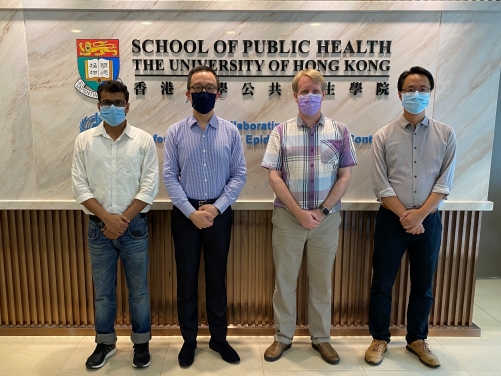HKUMed research suggested that the serial interval of SARS-CoV-2 can be shortened substantially over time by non-pharmaceutical interventions
HKUMed researchers have discovered that the serial interval of SARS-CoV-2 can be shortened substantially over time by non-pharmaceutical interventions. Conducted by scholars at the WHO Collaborating Centre for Infectious Disease Epidemiology and Control, School of Public Health, LKS Faculty of Medicine at The University of Hong Kong (HKUMed) and collaborators from the University of Cambridge, the United Kingdom; Institut Pasteur, Paris, France; Dalian Minzu University, China; University of Texas at Austin, The United States; and Beijing Normal University, China, the research team evaluated the serial intervals (i.e. the time between illness onset in successive cases in a transmission chain) of COVID-19 by compiling a line-list database of transmission pairs in mainland China. They concluded that the serial interval distribution of COVID-19 was substantially shortened in response to interventions, in particular isolation of cases. Identifying these changes over time can offer a better measure for evaluating the effectiveness of control measures. The findings are now published in the journal Science [link to publication].
The virus which causes COVID-19 spreads from one person to another, and the “serial interval distribution” is defined as the length of time between the symptom onset of consecutive cases in these chains of transmission. For example, if person A infects person B, the serial interval is the time between symptom onset of person A and symptom onset of person B. The distribution of serial intervals is important for estimating many other key epidemiological parameters (e.g. the reproduction number Rt), which are in turn used to predict disease trends and healthcare demands. Some previous studies have examined the serial interval distribution of COVID-19 in different locations, with estimates of the mean serial interval varying from 3.1 days to 7.5 days. These early studies each assumed the serial interval distribution was constant over time.
In the current study, the research team examined the serial interval distribution of COVID-19 and found that variation in the serial interval can occur. The mean serial intervals of COVID-19 shortened substantially from 7.8 days to 2.6 days within a month (January 9 to February 13, 2020).The serial intervals shortened because of the improvements in identification and isolation of cases, which reduced the chance of transmission later in illness. This work was based on a database of 1,407 COVID-19 transmission pairs, in which symptom onset dates and social relationships were available for both the infector and infectee of 677 transmission pairs.
The real-time assessment of changes in the serial interval distribution allows more accurate estimates of reproduction numbers than the traditional analysis assuming a constant serial interval distribution. These findings would improve assessment of transmission dynamics, forecasting future incidence, and estimating the impact of control measures.
About the research team
The research was conducted by: Dr Sheikh Taslim Ali, Research Assistant Professor, School of Public Health, HKUMed; Dr Eric Lau, Scientific Officer, School of Public Health, HKUMed; Professor Benjamin Cowling, Division Head of Epidemiology and Biostatistics, School of Public Health, HKUMed, and Co-Director of the WHO Collaborating Centre for Infectious Disease Epidemiology and Control; Professor Gabriel Leung, Dean of Medicine, Helen and Francis Zimmern Professor in Population Health, Chair Professor of Public Health Medicine, HKUMed, and Founding Director of the WHO Collaborating Centre for Infectious Disease Epidemiology and Control; Dr Lin Wang, Research Associate, Department of Genetics, University of Cambridge, the United Kingdom; the Mathematical Modelling of Infectious Diseases Unit, Institut Pasteur, Paris, France; Dr Xiao-Ke Xu, Assistant Professor, College of Information and Communication Engineering, Dalian Minzu University, China; Dr Zhanwei Du, Research Associate, Department of Integrative Biology, University of Texas at Austin, Austin, the United States; Professor Ye Wu, School of Journalism and Communication, Beijing Normal University, China; and Computational Communication Research Center, Beijing Normal University, China.
project was supported by the Health and Medical Research Fund, Food and Health Bureau, Government of the Hong Kong Special Administrative Region, China (grant no. COVID190118); Investissements d’Avenir program, the Laboratoire d’Excellence Integrative Biology of Emerging Infectious Diseases program (grant no. ANR-10-LABX-62-IBEID); European Research Council (grant no. 804744); European Union’s Horizon 2020 research and innovation program under grant agreement No. 101003589; National Institutes of Health (U01 GM087719); Open Fund of Key Laboratory of Urban Land Resources Monitoring and Simulation, Ministry of Land and Resources (KF-2019-04-034); National Natural Science Foundation of China (61773091, 11875005, 61976025, 11975025); and University of Cambridge COVID-19 Rapid Response Grant.

